These Adobo Pork Chops have been a staple in my home for years, and for good reason. The first time I made this Filipino classic, I was amazed at how just a few simple ingredients could create such incredible flavor.
Tender pork chops simmer in a mouthwatering blend of soy sauce, vinegar, and aromatic spices until they're perfectly juicy and infused with that signature tangy-savory taste that defines Filipino adobo.
What I love most about this recipe is how it transforms affordable pork chops into something truly special with minimal effort. Even better? The leftovers taste amazing the next day (if they last that long!).
What is Adobo?
Adobo is considered the national dish of the Philippines and refers to both the cooking method and the dish itself. The technique involves marinating meat, seafood, or vegetables in a mixture of vinegar, soy sauce, garlic, and spices, then simmering until tender.
This cooking method not only adds incredible flavor but also helps preserve the food in the warm tropical climate of the Philippines.
Jump to:
Why You'll Love This Recipe
- Simple ingredients that are likely already in your pantry
- Incredibly flavorful with minimal effort
- Make-ahead friendly - tastes even better the next day!
- One-pan meal for easy cleanup
- Perfect for meal prep as the flavors deepen over time
Ingredients
I've carefully selected these traditional Filipino adobo ingredients for their perfect balance of flavors. Pork chops provide a tender, juicy base that absorbs the marinade beautifully.
The dark soy sauce adds rich color and saltiness, while vinegar brings that distinctive tangy brightness that defines adobo. Crushed garlic, whole peppercorns, and bay leaves work together to create a fragrant, aromatic profile that makes this dish instantly recognizable.
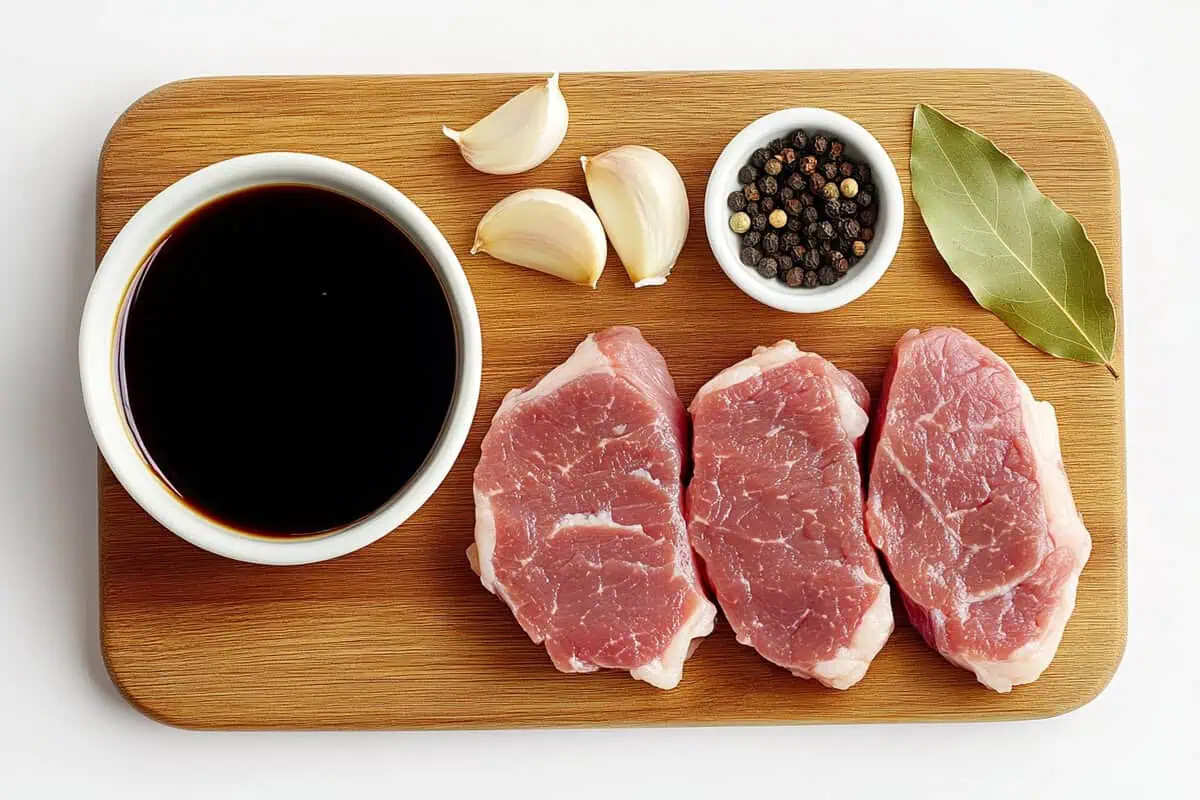
- 2 lbs pork chops
- 4 tablespoons dark soy sauce
- 5 cloves garlic, crushed
- 3 tablespoons white or cane vinegar
- 2 teaspoons whole peppercorn
- 4-5 pieces dried bay leaves
- 1 cup water
- Salt to taste (if necessary)
- 3 tablespoons cooking oil
Equipment
- Large deep skillet or Dutch oven
- Tongs for flipping the pork chops
- Sharp knife
- Measuring spoons and cups
- Garlic press (optional)
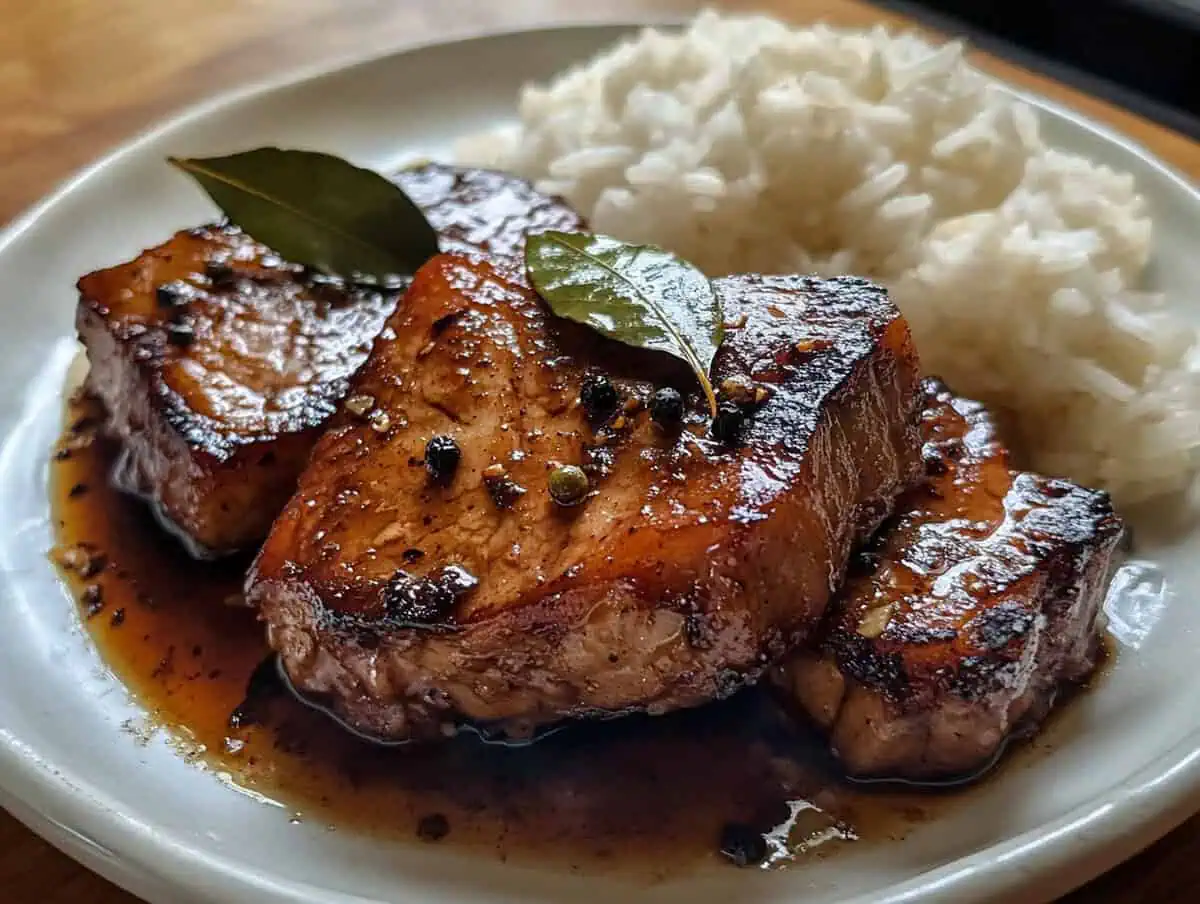
How To Make
- Heat cooking oil in a wide and deep pan over medium-high heat.
- Pan fry the pork chops, turning once, until each side turns light to medium brown (about 3-5 minutes per side depending on thickness).
- Add the aromatics - garlic, peppercorns, and bay leaves. Continue cooking until the garlic turns light brown (2-3 minutes).
- Pour in water and soy sauce. Bring the mixture to a boil.
- Cover and simmer until the liquid reduces by half (approximately 40-50 minutes). Add more water if needed to maintain some sauce.
- Add vinegar and allow the liquid to come to a boil. Stir and continue to cook uncovered for 10 minutes.
- Taste and adjust seasoning if needed. The soy sauce typically provides enough saltiness, but you can add salt according to your preference.
- Serve hot with steamed white rice.

Tips from Lola's Kitchen
- For more flavor, marinate the pork chops in the soy sauce, vinegar, and garlic mixture for 1-3 hours before cooking.
- Brown the pork chops well for a deeper flavor profile in the finished dish.
- Don't rush the simmering process - the slow cooking is what makes the meat tender and the sauce flavorful.
- For a thicker sauce, remove the pork chops once they're tender and reduce the sauce further before returning the meat to the pan.
- Let the dish rest for 10-15 minutes after cooking to allow the flavors to fully develop.
Substitutions
- Protein options: Try this recipe with chicken thighs, beef chunks, or firm tofu for a vegetarian version.
- Vinegar varieties: White vinegar is traditional, but apple cider vinegar or rice vinegar can offer different flavor profiles.
- Soy sauce alternatives: For a gluten-free version, use tamari. For less sodium, try coconut aminos.
- Fresh herbs: While dried bay leaves are traditional, you can add fresh herbs like thyme or oregano during the last 10 minutes of cooking for a different twist.
- Spice it up: Add 1-2 bird's eye chilies for a spicy version.
Troubleshooting
- Tough pork chops? Your cooking temperature might be too high or the chops might need more time to simmer. Next time, cook at a lower temperature for longer.
- Too salty? Add a peeled, quartered potato to the sauce while simmering—it will absorb some of the salt. Remove before serving.
- Too sour? Balance with ½ teaspoon of brown sugar or a splash more soy sauce.
- Sauce too thin? Remove the meat when done and simmer the sauce longer to reduce, or add a cornstarch slurry (1 teaspoon cornstarch mixed with 1 tablespoon cold water).
- Sauce too thick? Add a little more water or chicken broth.
Storage & Reheating
- Refrigeration: Store leftover adobo pork chops in an airtight container in the refrigerator for up to 4 days. The flavor actually improves after a day!
- Freezing: Freeze in a freezer-safe container for up to 3 months. Thaw overnight in the refrigerator before reheating.
- Reheating: For best results, reheat slowly in a covered pan on the stovetop with a splash of water to prevent drying out. Alternatively, microwave on medium power with a damp paper towel covering the dish.
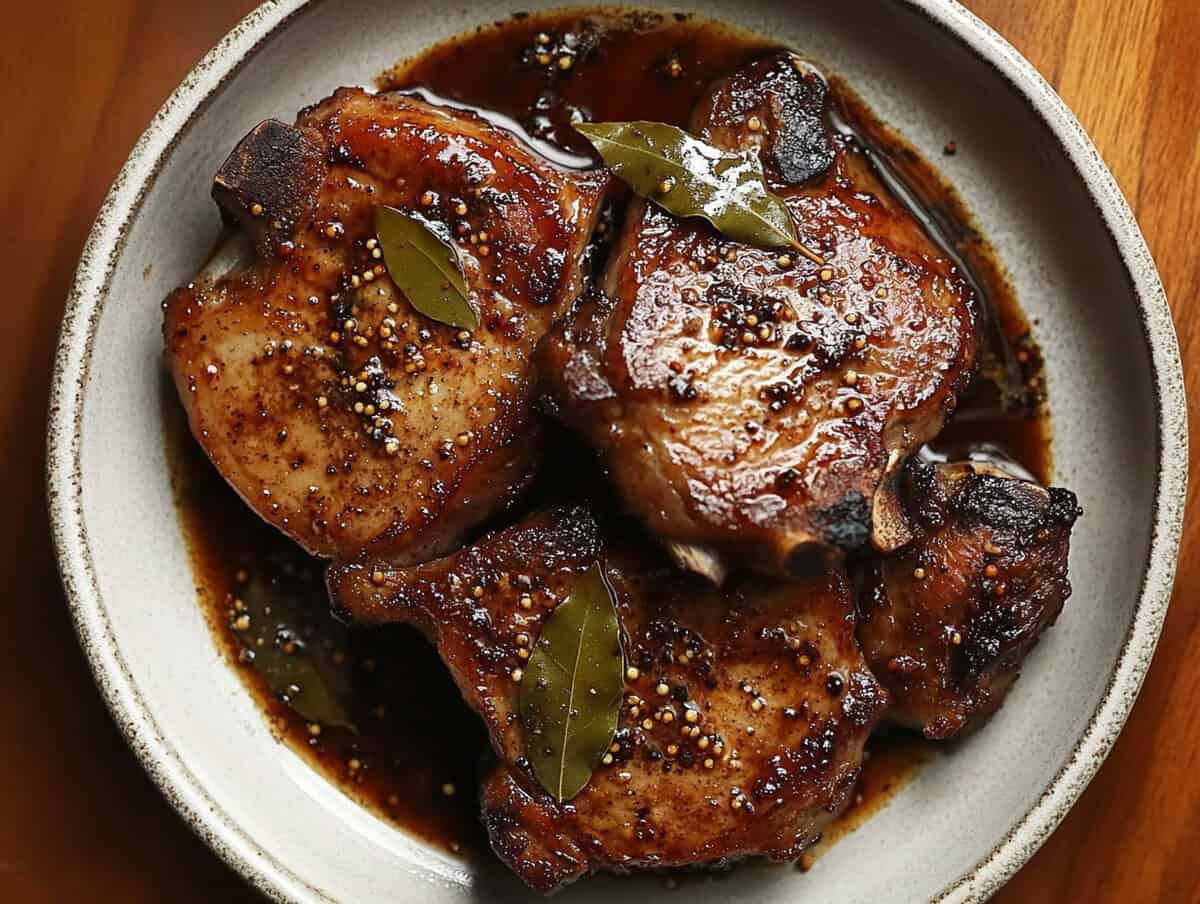
FAQ
Can I use bone-in or boneless pork chops?
Both work well! Bone-in pork chops tend to have more flavor and stay juicier, but boneless cook more quickly and are easier to eat.
What's the best rice to serve with adobo pork chops?
Steamed white rice is traditional, but garlic fried rice (sinangag), brown rice, or even jasmine rice are excellent options.
Can I make this in a slow cooker?
Yes! Brown the pork chops first, then add all ingredients to your slow cooker and cook on low for 6-7 hours or high for 3-4 hours.
How can I make this recipe healthier?
Use lean pork chops, reduce the oil to 1 tablespoon, and serve with brown rice or cauliflower rice instead of white rice.
Can I add vegetables to this dish?
Absolutely! Add hearty vegetables like potatoes, carrots, or eggplant during the simmering process, or quick-cooking vegetables like bell peppers or green beans during the last 10 minutes.
Is this dish spicy?
No, traditional adobo relies on the tanginess of vinegar rather than heat from chili. If you prefer some spice, add red pepper flakes or sliced chili peppers.
What wine pairs well with adobo pork chops?
A medium-bodied red wine like Pinot Noir or a crisp white wine like Sauvignon Blanc pairs nicely with the tangy flavor profile of this dish.
Related
Looking for other recipes like this? Try these:
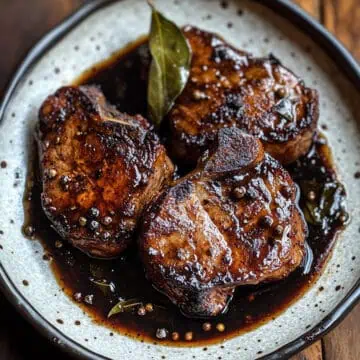
Adobo Pork Chops
Ingredients
- 2 lbs pork chops
- 4 tablespoons dark soy sauce
- 5 cloves garlic crushed
- 3 tablespoons white or cane vinegar
- 2 teaspoons whole peppercorn
- 4-5 pieces dried bay leaves
- 1 cup water
- Salt to taste if necessary
- 3 tablespoons cooking oil
Instructions
- Heat cooking oil in a wide and deep pan over medium-high heat.
- Pan fry the pork chops, turning once, until each side turns light to medium brown (about 3-5 minutes per side depending on thickness).
- Add the aromatics - garlic, peppercorns, and bay leaves. Continue cooking until the garlic turns light brown (2-3 minutes).
- Pour in water and soy sauce. Bring the mixture to a boil.
- Cover and simmer until the liquid reduces by half (approximately 40-50 minutes). Add more water if needed to maintain some sauce.
- Add vinegar and allow the liquid to come to a boil. Stir and continue to cook uncovered for 10 minutes.
- Taste and adjust seasoning if needed. The soy sauce typically provides enough saltiness, but you can add salt according to your preference.
- Serve hot with steamed white rice.
Tips from Lola's Kitchen
- For more flavor, marinate the pork chops in the soy sauce, vinegar, and garlic mixture for 1-3 hours before cooking.
- Brown the pork chops well for a deeper flavor profile in the finished dish.
- Don't rush the simmering process - the slow cooking is what makes the meat tender and the sauce flavorful.
- For a thicker sauce, remove the pork chops once they're tender and reduce the sauce further before returning the meat to the pan.
- Let the dish rest for 10-15 minutes after cooking to allow the flavors to fully develop.
The Story Behind Filipino Adobo Pork Chops
Filipino adobo is much more than just a dish – it's a cornerstone of Philippine cuisine that tells the story of the country's rich cultural history. Long before refrigeration existed, ancient Filipinos discovered that cooking meat in vinegar helped preserve it in the tropical heat. This practical preservation method evolved into what we now know as adobo, the unofficial national dish of the Philippines.
The word "adobo" actually comes from the Spanish term "adobar," meaning to marinate or season. When Spanish colonizers arrived in the Philippines in the 16th century, they observed locals cooking meat in vinegar and applied their own familiar term to this cooking method. However, Filipino adobo existed long before Spanish influence, with indigenous peoples using native ingredients like coconut vinegar, peppercorns, and salt to preserve and flavor their food.
What makes Filipino adobo truly unique is its perfect balance of sour, salty, and savory flavors. When Chinese traders introduced soy sauce to the Philippines, it gradually replaced or supplemented salt in many adobo recipes, creating the soy sauce-vinegar combination we know today. This evolution perfectly represents how Filipino cuisine has been shaped by various cultural influences while maintaining its distinctive character.
Every Filipino family has their own special adobo recipe. Some versions are dry, while others are saucy. Some families add coconut milk for creaminess, others include turmeric for color, and some toss in chili peppers for heat. This adaptability is part of what makes adobo so beloved – it can be customized to suit any taste preference while still maintaining its essential character.
Pork chops became a popular cut for adobo because they cook relatively quickly while remaining tender in the acidic marinade. The bone-in varieties add extra flavor to the sauce as they simmer. Today's recipe for Adobo Pork Chops represents a convenient, weeknight-friendly version of this classic dish that doesn't sacrifice any of the traditional flavor that has made it a favorite for generations.
Making adobo at home connects you to centuries of Filipino cooking tradition. As the aromatic blend of garlic, bay leaves, peppercorns, soy sauce, and vinegar fills your kitchen, you're experiencing the same sensory delights that have made this dish a comfort food staple across the Philippine archipelago and now, around the world.
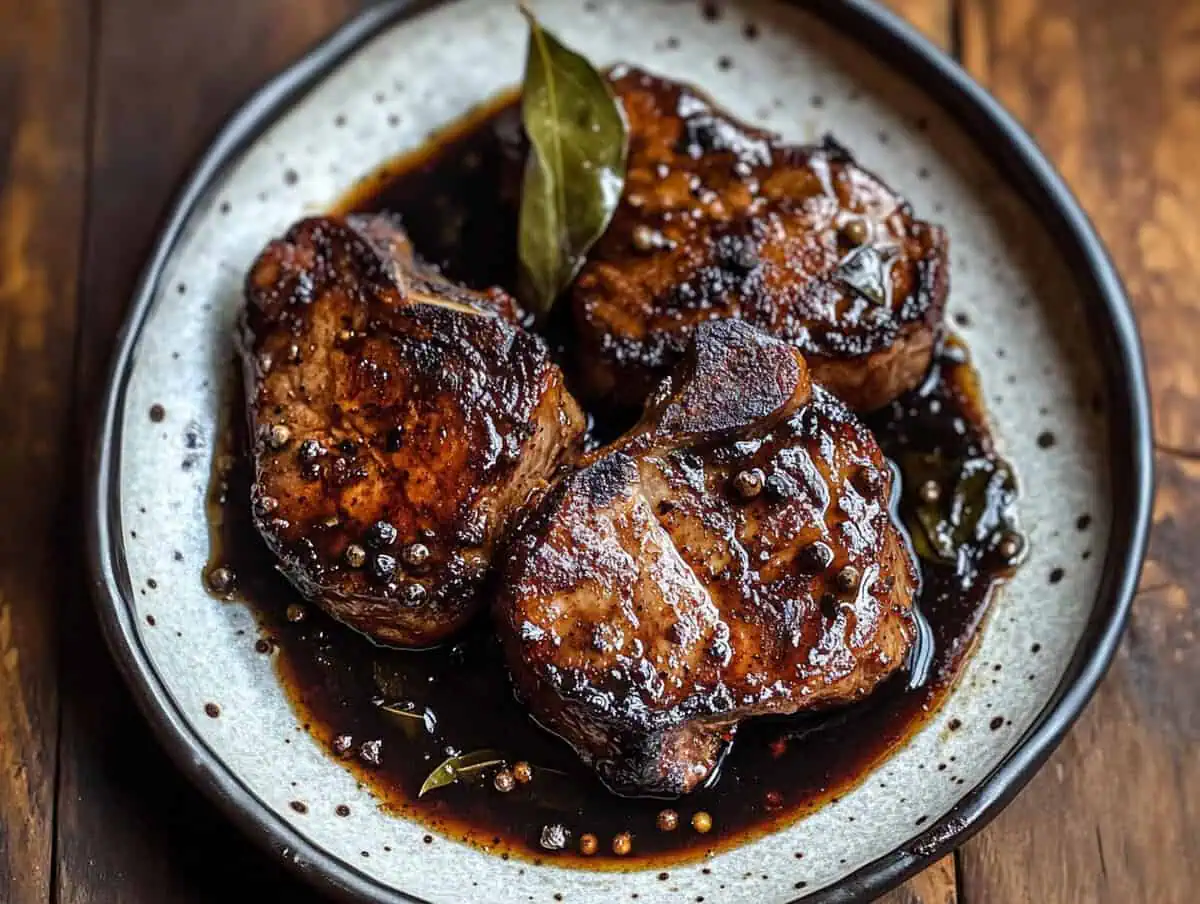








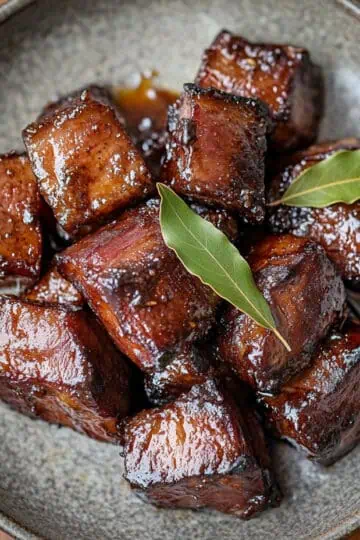
Comments
No Comments